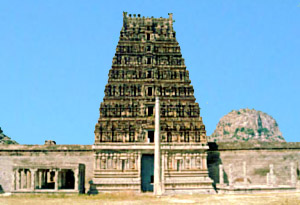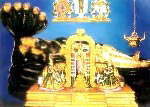 Anantpur is the largest district of Andhra Pradesh, with an economy based on partial industrialisation, but chiefly depending on agriculture. The major cities and villages of the district happen to have a place of pilgrim in almost every corner, evidence of temple architectures. Temples in Anantapur district therefore has become the logo of religiosity of the place. Some of the temple towns and their temples include- the Lepakshi Temple, Veerbhadra temple, the region of Tadipatri temples of Bugga Rama Lingeshwara Swami Temple, Aluru Ranganatha Swamy Temple, Chintala Venkata Ramana Swamy Temple. The famous Hanuman Temple, the 400-year old Lord Lakshmi Narasimha Swami Temple constructed by Raja Krishna Deva Raya. Also the region of Puttaparthi is distinguished as the hometown of Bhagwan Sri Satya Sai Baba, regarded as the holy incarnation of the almighty. Then again the temples around Rayadurg, Dharmavaram, Hemavathi, Atmakur, Bhyravanithippa, Chitrachedu, Penna Ahobilam, Kadiri and Kasapur are worth mentionable too. Almost all of them were built in the pre-historic era (with extravagant handiwork), the structural pattern resembling each other. The temples of Anantapur has also attracted tourist all over the country whilst supporting the tourism industry.
Anantpur is the largest district of Andhra Pradesh, with an economy based on partial industrialisation, but chiefly depending on agriculture. The major cities and villages of the district happen to have a place of pilgrim in almost every corner, evidence of temple architectures. Temples in Anantapur district therefore has become the logo of religiosity of the place. Some of the temple towns and their temples include- the Lepakshi Temple, Veerbhadra temple, the region of Tadipatri temples of Bugga Rama Lingeshwara Swami Temple, Aluru Ranganatha Swamy Temple, Chintala Venkata Ramana Swamy Temple. The famous Hanuman Temple, the 400-year old Lord Lakshmi Narasimha Swami Temple constructed by Raja Krishna Deva Raya. Also the region of Puttaparthi is distinguished as the hometown of Bhagwan Sri Satya Sai Baba, regarded as the holy incarnation of the almighty. Then again the temples around Rayadurg, Dharmavaram, Hemavathi, Atmakur, Bhyravanithippa, Chitrachedu, Penna Ahobilam, Kadiri and Kasapur are worth mentionable too. Almost all of them were built in the pre-historic era (with extravagant handiwork), the structural pattern resembling each other. The temples of Anantapur has also attracted tourist all over the country whilst supporting the tourism industry.
Venkatramana Temple
Location: Tadpatri near Gooty (Anantapur)
Deity: Venkataramana
This temple also belongs to the Vijayanagar period. This 6th century temple has intricate work on the walls and pillars of the Mandapams.
Doddeswara Swamy Aalayam Temples
Location: Hemavati near Madakasira, Anantapur
Deity: Lord Shiva
The village has four famous Sivalayas built and patronised by Pallavas here, where the Nolamba artists made the sculptures. Among the four Siddheswara, Virupaksheswara, Malleswara and Doddeswara temples, the last one is famous for its six-foot-high Sivalinga. The walls are covered with images sculptured that narrate stories from the great epics Mahabharata and Ramayana. This temple was constructed during the eighth century.
Bhogeswaraswamy Aalayam Temple
Location: Pamidi near Gooty-Anantapur
Deity: Lord Shiva
Lord Parasurama built this aalaya at the foot of Simhagiri hill. He installed the idols of Gauri and Shankar along with Kesavaswami. Agasthya, Rishyasringa and Simhagiri Bhat performed penance here. The Shivalinga is about five feet in high and swyambhu. As the serpent entwines the Sivalinga, it was appropriately called Bhogeswaralinga. The temple is adorned with beautiful sculptures representing Nandi, Navagrahas, and Vinayaka etc.
Legend: A cowherd observed one of his cows standing over an anthill and allowing its milk to flow down into it. He tried to break it with an axe - a voice informed him to leave it and to build an aalaya for Lord Bhogeswaraswamy. The next day he removed the anthill and found a big Sivalinga encircled by a serpent. He built an aalaya over it and another one for Goddess Parvati. He was instructed in his dream by Adisesha to build a small hamlet around, and name it Seshagrandhipuram.
 Bugga Ramalingeswara Temple
Bugga Ramalingeswara Temple
Location: Tadparti near Anantapur
Deity: Lord Shiva
There are two temples here the Bugga Ramalingeswara Temple and the Chintala Venkataramana Temple. Both are situated on the banks of river Pinakini, which becomes Uttara Vahini, and is considered as a sacred spot.
The Siva temple faces the west and is more ancient. This place was called Bhaskara Kshetras and had plenty of palm trees hence was called Tamlapalli (Tati Vanain) and was renamed as Tadpatri. The icon of the Lord is uncut and roughly formed and hence the popular tradition is that the Linga is Swayambu or self manifested.
Legend: Lord Parashurama lived and performed penance here worshipping Lord Siva. There is an underground water stream that trickles into the Garbha Griha, where the Siva Linga was consecrated.
Ramalingeswara Temple
This temple dates back to the 15th Century Vijayanagar Empire and has elements of Chalukyan, Chola and Vijayanagar art. According to legend the spot where Ramalingeswara temple stands, Lord Parashurama lived and performed penance here. The idol is uncut and roughly formed and hence the popular tradition that the linga is Swayambu.
Veerabhadra Temple (Lepakshi)
The temple is an example of Vijayanagar architecture and was built in the 16th century and is situated on a mound. A huge granite nandi bull stands outside and is carved out of single rock. The ceilings are covered in mural paintings. It is constructed on low rocky hill, which the locals call as Kurmasaila, because it resembles a tortoise.











